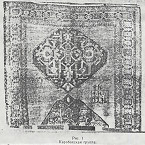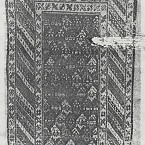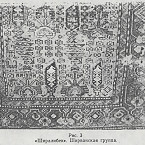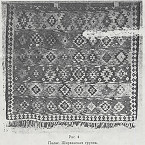 |
Najiba Abdullaeva was the senior researcher in the Kerimov group in the folk art section of the Academy of Arts and Sciences. While her professional career did not begin until the close of the period which she discusses, it was relatively recent history. In reading what she has to say it would be good to ignore some of the genuflecting to soviet power; as one area specialist once remarked, the Azeris learned how to dance with the bear. Extensive work done to authenticate designs was done in 1900 or thereabouts, and the activity of the 1920’s here described is rather likely to have extended what had been done. Indeed, many of the folk art professionals successfully continued their imperial era work in soviet times. The article is not well written and has many redundancies. This translation nevertheless sticks pretty much to the text. The images -- poor xeroxing of poor photos -- are awful but are recognizable. NEWS BULLETIN OF THE AZERBAIDZHAN ACADEMY OF SCIENCES [1] N.A. ABDULAYEVA [2] Pertaining to the history of the art of carpet weaving in Soviet Azerbaidzhan (1920 - 1929) By the time the Soviet power was established In Azerbaidzhan the rug trade in the region had already reached almost complete decline. The establishment by the end of the 19th c. of large factories which operated on cheap labor force in Iran, Turkey and other countries, and introduction of mechanical looms to the manufacturing of rugs in those regions caused a drop in the prices of rugs manufactured manually. This had an effect on Azerbaijan carpet-weaving, its economic role worsening each day; in spite of this production and sales of carpets increased. First World War 1 and then the Civil War with an ensuing economic crisis in the collective economy of the young Soviet republic caused the collapse of the Azerbaidzhan rug industry. The number of sheep whose wool served as the primary raw material in the manufacturing of rugs had plummeted. Being cut off from the foreign markets interfered with attempts to export the rugs, and the cessation of the supply of dyes also slowed down the manufacturing process. Prices of rugs were rapidly falling; the costs of the manufacturing could no longer be covered. The poor quality of dyes and lack of good wool made the situation even worse. New conditions of life demanded subsequent changes in the manufacturing of rugs. In the fall of 1920, wishing to help the kustary and [other] small [goods] producers, the Azerbaidzhan Sovnarkhoz department of cooperative handicraft and light industries ordered the Soviet national economies of Gyanzha, Shusha, Nukha, Agdash, Lenkoran, Salyan, Kuba, and Shemakha to register all of the kustary [home industry craft persons] and all of the small producers artels. In spite of the measures taken by the young Soviet Government the sharp degeneration of the rug industry in 1917-1920 could not be alleviated immediately. Due to the high cost of raw materials and high cost of production it became very hard to improve the situation in which the kustary found themselves. The decline in the rug Industry continued until 1924. Created in 1924, an organ of the department of Transcaucasia’s of foreign trade, Aktsionernoe (Narkomat), the “Zakgostorg” stock holding society made its goal the improvement of the rug industry and an increase in the export of rugs to the world market. These policies had a lasting impact on the kustary of Azerbaidzhan. Zakgostorg began to collect examples of the best antique Azerbaidzhan rugs. Compositions of Azerbaidzhan rug motifs whose patterns had kept their authenticity were sketched in water colors. Sometimes the whole composition would be sketched as one and sometimes in halves. Then the patterns would be transferred onto special paper one millimeter thick for technical drawing. Subsequently in 1928 all of the color drawings were sent to Leipzig, edited there in the form of an album with 50 compositions of both piled and plied [flatwoven] rugs. The edition was of many copies and was widely circulated. Both the Baku and Tblisi lithograph [facilities] began to produce technical drawings of different rugs for the kustary of the republic. Thus Zakgostorg aimed to further the general installation of technical drawing into the manufacturing of rugs in order to improve the artistic quality of the product. The sketching of rug compositions took place in the art department of the experimental art studio organized as a sub department of Zakgostorg in Tblisi. The artists working in the studio were ten in number. Those called were skilled artists and very knowledgeable about rug manufacturing – such as G. A. Milokhov, A.N. Sklifasovski, A.N. Tsitshvili, N. Vasileva and others. The weaving section of the studio was looking at better ways of utilizing various fibers (wool, cotton, silk) [for] the warp and the weft of a rug, and also at the utility of different methods of weaving at different pile heights, and at the production of plied rugs and pile carpets. During the period from 1920 to 1928 experts were using old rugs as models and were copying them. The main areas of Azerbaidzhan which were engaged in the manufacturing of rugs of that period were: 1) Kuba, the largest rug manufacturing area in Azerbaidzhan; 2) Kazakh, which had a special place because of the sheer number of produced rugs; 3) Gyandzha (today Kirovobad); 4) Agdam, [a town north of Shusha] including all Karabakh [types]: (figures 1, 2); 5) Shirvan (figures 3, 4) and 6) Baku. Wishing to learn the potential for the further development of carpet weaving in Azerbaidzhan, Zakgostorg decided to organize a series of exhibits in the main rug manufacturing regions. In January 1926 Kazakh saw the first rug exhibit not only in the Soviet period but the first in the history of Azerbaidzhan. This exhibit took place in a club where 107 rugs were brought from nearby villages by the peasants. [3] These were the first rugs produced in 1924-1925. Those made before the war were not allowed at the exhibit because its goal was to show the success and development of the rug business during the Soviet period. In midday the exhibit was moved outside and laid out on the grass. This way many more people could enjoy the exhibit. Among the rugs were many very valuable in an artistic sense. There were rugs which qualitatively and artistically were equal to the pre-war ones. The best rugs were represented by the towns of: Kaimakhly, Shikhly, Poily, Ashaga Salakhly, Gyrakh Kesemen, Dash Salakhly, Chalily. Two rugs, including one from Shikhly, received first prizes – “diplomas of the first degree” - 50 rubles each; second prizes - 35 rubles each; third prizes - 25 rubles each. Since the owners refused to sell their rugs Zakgostorg was able to buy only one rug which was awarded third prize. Several other rugs were bought. Those rugs although not awarded prizes were undoubtedly very valuable from an artistic standpoint. The exhibit showed that the quality of rug handicraft in Kazak had not become worse. It became obvious that the majority of the villages of the area have great potential for successful development of carpet weaving. Giving prizes to the best rugs served to reward their makers and to encourage continued production of rugs which are highly artistic. For successful attaining of that goal Zakgostorg increased the prices [it would pay] for rugs it purchased. Undoubtedly this made the kustary more interested in the production of rugs and aided greatly the further development of the weaving business in Kazakh. Later, Zakgostorg planned exhibits in Gyandzha, Nukha, Karabakh, Kuba. The goal of these exhibits was to increase the “culture” of carpet weaving and to organize the rug business in other areas of the republic. Supplying the kustary with readily available yarn, dyes and technologically modern looms helped greatly to improve the method of the production of goods. “ If only three years ago the poor quality of local rugs worried people who could appreciate them”, notes the author of an article in the newspaper, Baku Worker, “now one can find carpets of unique colors and patterns which makes them stand out by their neatness and the strickness of [i. e. care in] manufacturing. The exhibit has demonstrated that the Soviet rug is growing.” [4] Carpets represented an important part of the budget [i.e., revenue] of the Transcaucasian republics, were established in the world market, and were important to the economies of the republics. Linking economic recovery and the future development of carpet-making will acquire greater importance for all of the republics. Such is the case with Azerbaijan -- which produces the largest share of carpets made in the republics of the Transcaucasian federation -- since carpet-weaving here is one fourth of [its] economic activity. In consideration of this Zakgostorg formed a special fund; 15% of the profit from marketing operations during the 1924-1925 period went to various activities designed to improve the carpet weaving business, particularly the improvement of the manufacturing of yarn from a higher quality wool and its sale to the kustary at cost, as well as improvement in the quality of artificial dyes. The next rug exhibit was organized by Zakgostorg on March 23-24, 1926 in another very important area of rug manufacturing -- Kuba. Kuba’s exhibit helped to reveal the potential of that area which has manufactured rugs of the highest sort and of highest artistic quality. After a very thorough selection the exhibit had over two hundred rugs made by the modern method. Professor V.M. Zummer in his article dedicated to the Kuba exhibit wrote: “Not one rug which was unsatisfactory artistically or qualitatively made it to the exhibit. Rough poorly made street rugs with patterns of dogs and cats could only be seen in the hands of the second-hand dealers who were offering them to the public outside of the exhibit.” [5] Kuba's exhibit was supposed to pour some light on such questions as “How does the artistic value of the contemporary rug compare with that of the older type? In what way does the modern rug tradition resemble the older one in terms of pattern and technique; in what way do the traditions differ [from] what is the general appearance of the modern Kuba rug; what are the local modifications of that look; and, what are the needs and perspectives of the further development in the rug industry in the area and in surrounding areas?” [6] Numerous contemporary rugs woven in the period of 1920 to 1926 and displayed at the exhibit made clear that in six years what a tremendous number of rugs must have been manufactured by local weavers. Among the best rugs at the exhibit were rugs from the village of Perebedil’, which because of their classic composition took the first, second and third prizes. The first prize was awarded to Zibelda Yarmamedova who V.M. Zummer called “Peasant-artist”. Her rug was not large, 2.2 arshins [5’ 1”] by 1.5 arshins ] [3’ 6”]. Recapitulating the “Perebedil’” theme her rug did not, however, show any blank spots nor was it too thickly patterned. Its maker depicted various figures on the field of the rug in a very harmonious way which proved that she indeed had much talent and taste. Yarmamedova emphasized the center of her rug by placing there the largest element of her composition, an octagonal medallion. Close adherence to the density of the weave characteristic of this type of rug enabled her to achieve correctness of the designs and to avoid distortions which often happened due to a disparity in the thicknesses of yarns in the weft, warp, and pile, and due to overzealous beating down of the weft. The rug was made with great love and skill. Ridding the rug of all excesses Yarmamedova made it clear and attractive in its composition. The second prize was awarded to a rug of the same village but of a different composition. This composition was called “Gerat [Herat] Perebedil’”. The pattern of the rug consisted of the plant motif often seen on Iranian rugs, “Farkhan”, but in this case was modified and gained a new look. Special splendor was added to the rug by small white flowers characteristic of this type of composition, which accented the warm tones of the borders, and the red and deep blue tones of the overall coloring. Many villages in the Kuba area manufacture rugs of their own composition, differing from others. The town of Karagashly had two examples at the exhibit; one of them won the first prize. In the center of the rugs along the vertical [axis] are stylized four-sided medallions characteristic of that composition. The space between the medallions is filled up with geometric shapes representing animals, birds, figures of horsemen. At the first glance primitive, these rugs are not, however, without expression and attractiveness. The village of Chichi, Kuba area, is also known for its rugs. Chichi's rugs are known for their high quality, attention to detail and artistic skill. Usually some sort of small plant motifs liven up the darker tones of the rugs. These rugs seem to reflect the plentiful nature of the surrounding area. The jury of the exhibit gave one of the second prizes to a rug of this sort. Meriting praise were rugs from the towns of Kimil’ (two third prizes); Kryz, Konakend, Zeiva, Gasankala and Imamkulikend all received high praise at the exhibit. Out of two hundred rugs only ten received prizes; two first prizes, three second prizes, and five third prizes. When evaluating the achievements in the reconstruction and development of the rug industry in the republics of that period, one has to view the second exhibit in Soviet Azerbaidzhan as that Kuba‘s kustary continue to make rugs of high artistic value. So Azerbaijan must not rest on these achievements, which the second exhibition at Kuba clearly demonstrated, by the Kuba masters, that traditional carpet-making currently established in this zone continued to have high artistic value. At the Kuba exhibit Zummer in his opening speech said “This art is wise in its simplicity, able to combine life experiences and observations within the strict confines of a standard style -- we believe that this art is alive and full of potential for the future. Honor and glory to the women of Azerbaidzhan. To these peasant-weavers who while living simple and poor lifestyles have been able to nurture, foster and save for our times the flowers of their patterns. The time will come when a carpet created by a life of penury will become the foundation of the future artistic wealth of the area ” [7] Rug exhibits in the largest areas of carpet-weaving created a huge interest in the population. They took on “educational” character and became local “labor festivities”. The Soviet government’s concern and help to the rug industry of the region and had an extremely successful result: In 1926-1927 the number of craftswomen in the region doubled when compared with the period of 1924-1925. In 1924-1925 there were 3703 craftswomen in the Kuba zone. The number of rugs manufactured by them was 4415. In two years the number of craftswomen reached 4414 and the number of rugs manufactured by them reached 7110. According to the data of M.D Isayev, a researcher of the carpet weaving industry in Trans-Caucasia the critical position of the industry during the first years of the Soviet government was by 1928-29 completely liquidated. [8] The appearance of cooperatives, 1927—1928, in Azerbaidzhan’s carpet manufacturing did not drastically modify the productive-organizational relations. Kustar’ cooperatives appeared in the simplest of forms. The weavers united in artels and societies for those who worked at home. The societies and artels supplied them with raw materials, dyes and technical drawings with exact calculations of density and dimensions. This aided greatly in improving the technical level of rug manufacture, since the drawing was directly related to the question of thickness and commensurability of different yarns, plies, wefts and warps. Artels were engaged in the sale of the rugs produced by their members and thus eliminated the middle-man factor. This was of immense benefit to the kustary who prior to the formation of artels were dispersed, lacked the means of normal communication, and relied on travelling buyers or middle-men who bought their goods at below market prices. Another reason for the improvement of productivity was the supply of ready-to-use yarn. Before crafts persons had to spend tremendous amounts of time in processing of raw materials. By 1927 there was an association of kustary, “Azsanatbirlig”, one of the large societies which included Azkhalchabirgi (Azerbaidzhan Rug Union). Lenin’s motto, “Real cooperation of real masses” began to come to life. Seeing the advantages of cooperation the crafts persons were convinced in its profitability. However, artels and societies of the time could not include all of the kustary. For that a complete reconstruction of all of agriculture in the country was necessary. Many large wool producing farms were still concentrated in the hands of kulaks [rich peasants] and dye shops belonged to private persons. Also there was lack of trained cadres among the cooperatives leaders. Research conducted by Zakgostorg and the Transcaucsian Central Statistical department, along with the rug exhibits in the largest centers of the rug industry, showed the potential for high quality rug manufacturing in the area. By the beginning of 1929, clear improvement in the condition of the rug industry could be observed in many areas. The economic importance of the carpet industry in the life of the people, the need for rugs by the population of the area, and steady demand for the rugs in the foreign market determined the success of the later development of this valuable branch of folk art. [1] Social Sciences Series, 1961, No. 8. [2] Without her invitation to the first carpet conference in Baku, 1983, it is likely that Research Report never would have happened. Her discussion of the preceding period, �The Development of Rug-Weaving�in the Beginning of the 20th Century�, appears in Oriental Rug Review, October/November, 1992. [3] Baku Worker, Feb 1, 1926. [4] Feb. 1, 1926 [5] Zummer, V. M., Modern Kuba Rugs, Izvestia, Society of Research and Study of Azerbaijan, 1926, #3. [6] Ibid. [7] Zummer, Bakinskii rabochii rabochii. op. cit. [8] Isaev, M. D., Kovrovoe proizvodstvo zakavkazya, Tiflis, 1932, p. 36
Copyright � Richard E. Wright, All Rights Reserved |



